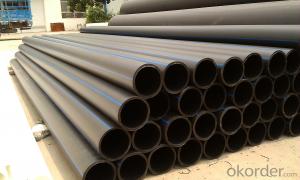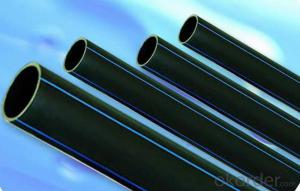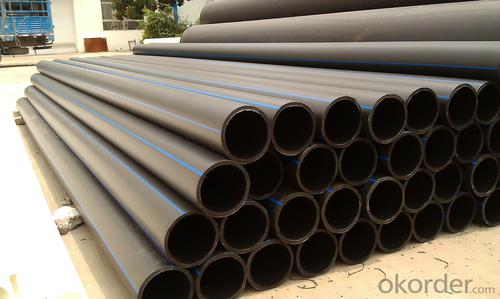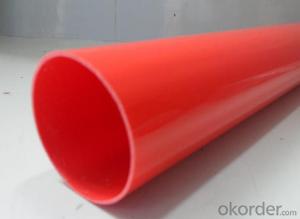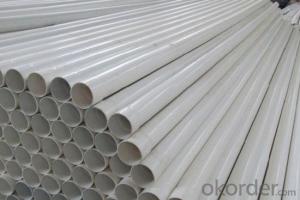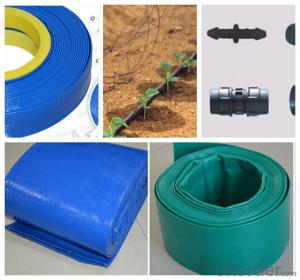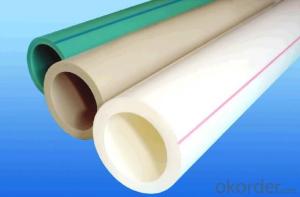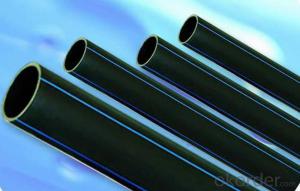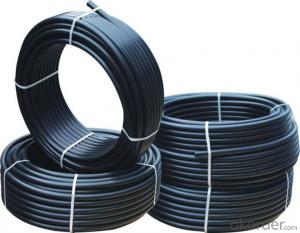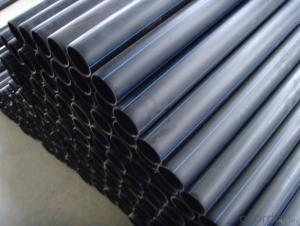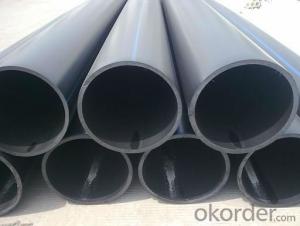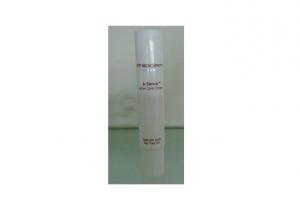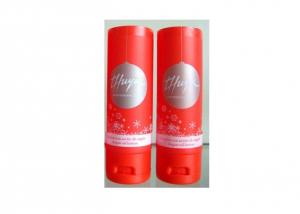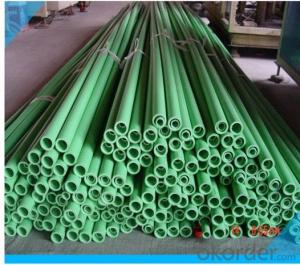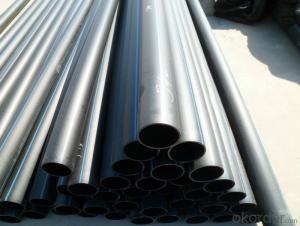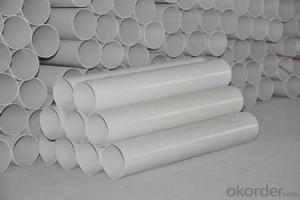Plastic Tubes HDPE Pipe 80
- Loading Port:
- China Main Port
- Payment Terms:
- TT OR LC
- Min Order Qty:
- -
- Supply Capability:
- -
OKorder Service Pledge
OKorder Financial Service
You Might Also Like
Physical properties[edit]
Polyethylene is a thermoplasticpolymer consisting of long hydrocarbon chains. Depending on the crystallinity and molecular weight, a melting point and glass transition may or may not be observable. The temperature at which these occur varies strongly with the type of polyethylene. For common commercial grades of medium- and high-density polyethylene the melting point is typically in the range 120 to 180 °C (248 to 356 °F). The melting point for average, commercial, low-density polyethylene is typically 105 to 115 °C (221 to 239 °F).it is transprant.
Chemical properties[edit]
Most LDPE, MDPE and HDPE grades have excellent chemical resistance, meaning that it is not attacked by strong acids or strong bases. It is also resistant to gentle oxidants and reducing agents. Polyethylene burns slowly with a blue flame having a yellow tip and gives off an odour of paraffin. The material continues burning on removal of the flame source and produces a drip.[3] Crystalline samples do not dissolve at room temperature. Polyethylene (other than cross-linked polyethylene) usually can be dissolved at elevated temperatures in aromatic hydrocarbons such as toluene or xylene, or in chlorinated solvents such as trichloroethane or trichlorobenzene.[4]
GB/T13663-2000:
| PE63管材规格 | |||||
| 公称 外径dn,mm | SDR33 | SDR26 | SDR17.6 | SDR13.6 | SDR11 |
| 公称压力 PN,Mpa | |||||
| 0.32 | 0.4 | 0.6 | 0.8 | 1.0 | |
| 公称 壁厚 | 公称 壁厚 | 公称 壁厚 | 公称 壁厚 | 公称 壁厚 | |
| 16 | 2.3 | ||||
| 20 | 2.3 | 2.3 | |||
| 25 | 2.3 | 2.3 | 2.3 | ||
| 32 | 2.3 | 2.4 | 2.9 | ||
| 40 | 2.3 | 2.3 | 3.0 | 3.7 | |
| 50 | 2.3 | 2.9 | 3.7 | 4.6 | |
| 63 | 2.3 | 2.5 | 3.6 | 4.7 | 5.8 |
| 75 | 2.3 | 2.9 | 4.3 | 5.6 | 6.8 |
| 90 | 2.8 | 3.5 | 5.1 | 6.7 | 8.2 |
| 110 | 3.4 | 4.2 | 6.3 | 8.1 | 10.0 |
| 125 | 3.9 | 4.8 | 7.1 | 9.2 | 11.4 |
| 140 | 4.3 | 5.4 | 8.0 | 10.3 | 12.7 |
| 160 | 4.9 | 6.2 | 9.1 | 11.8 | 14.6 |
| 180 | 5.5 | 6.9 | 10.2 | 13.3 | 16.4 |
| 200 | 6.2 | 7.7 | 11.4 | 14.7 | 18.2 |
| 225 | 6.9 | 8.6 | 12.8 | 16.6 | 20.5 |
| 250 | 7.7 | 9.6 | 14.2 | 18.4 | 22.7 |
| 280 | 8.6 | 10.7 | 15.9 | 20.6 | 25.4 |
| 315 | 9.7 | 12.1 | 17.9 | 23.2 | 28.6 |
| 355 | 10.9 | 13.6 | 20.1 | 26.1 | 32.2 |
| 400 | 12.3 | 15.3 | 22.7 | 29.4 | 36.3 |
| 450 | 13.8 | 17.2 | 25.5 | 33.1 | 40.9 |
| 500 | 15.3 | 19.1 | 28.3 | 36.8 | 45.4 |
| 560 | 17.2 | 21.4 | 31.7 | 41.2 | 50.8 |
| 630 | 19.3 | 24.1 | 35.7 | 46.3 | 57.2 |
- Q: How to remove the rust plastic pipe
- The so-called "rouge" is actually "rust".
- Q: Are plastic tubes suitable for use in the oil and gas industry?
- Plastic tubes are generally not suitable for use in the oil and gas industry due to their limited strength and resistance to high temperatures and pressure. The industry typically requires materials that can withstand harsh conditions and ensure the safety and reliability of operations, which are better met by using materials like steel or flexible pipe systems specifically designed for oil and gas applications.
- Q: Can plastic tubes be easily labeled or branded?
- Yes, plastic tubes can be easily labeled or branded. They provide a smooth surface that allows for clear and durable printing of logos, text, or any other desired branding elements. Additionally, various labeling techniques such as adhesive labels, screen printing, or direct printing methods can be used to customize and brand plastic tubes efficiently.
- Q: How to calculate joint parts for hot melt connection of water supply plastic pipe?
- The hot melt connection directly connects the pipe and does not need the fittings,If flanges, flanges, or hot melt inserts or electrofusion connections are used, the fittings shall be determined according to the design drawings and field conditions.
- Q: I have a little bit of a project. I'm trying to figure a way to cool a pair of water filled tubing lines. I was thinking to wrap it with some type of cooling device but not quite sure what to use. Can you guys give me some ideas? I want to cool the lines as cool as refrigerator temps. Thanks.
- You have not said how much heat you need to disperse - whether it needs to be a continuous process or not. You have not mentioned whether the lines are flexible or what length they are! However, without making things too complicated, if you use a longish length of plastic tubing, you could coil them and run them through a bucket full of an ice/salt/water mixture. Depending on how fast the water is moving through the tubes, if you had a strong mixture of salt and ice - with just enough water in the bucket to allow conduction - you might be able to freeze the water in the tubes - which is probably NOT what you want to do. So experiment before the performance.
- Q: Can plastic tubes be transparent?
- Yes, plastic tubes can be transparent.
- Q: How are plastic tubes cut to specific lengths?
- Plastic tubes are cut to specific lengths using various methods such as sawing, scoring and snapping, or using a tube cutter tool.
- Q: How do you connect the white plastic tube with the PPR tube?
- I don't know. What's the diameter of the white plastic tube?. The small pipe needs joint.Thick pipe, if it is not tap water, pressure is not the case, you can directly white plastic pipe, hot water, wearing gloves, directly inserted into the pipe PPR tube, five cm or so can be.It's better to have a flamethrower, bake the tube and put it in
- Q: I had pains in my vagina, so my Dr. had to see if there were any lumps that were causing the pain. He had to stick this tube thing up my vagina to look inside. It hurted really bad. My hymen isn't there anymore, so I was wondering if I was still a virgin?
- yes, you are still a virgin. The only way to not be a virgin is to have sexual intercourse with either a man or woman.
- Q: How do plastic tubes compare to Teflon tubes in terms of chemical resistance?
- Plastic tubes generally have good chemical resistance, but Teflon tubes are known for their superior chemical resistance properties. Teflon tubes can withstand a wider range of chemicals, including highly corrosive substances, making them more suitable for applications requiring high chemical resistance.
Send your message to us
Plastic Tubes HDPE Pipe 80
- Loading Port:
- China Main Port
- Payment Terms:
- TT OR LC
- Min Order Qty:
- -
- Supply Capability:
- -
OKorder Service Pledge
OKorder Financial Service
Similar products
Hot products
Hot Searches
Related keywords
